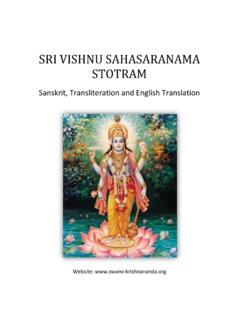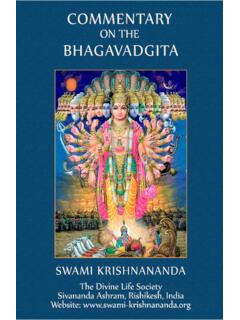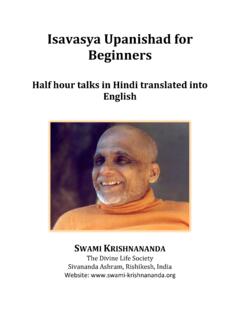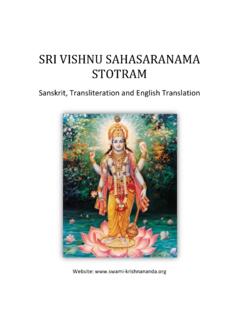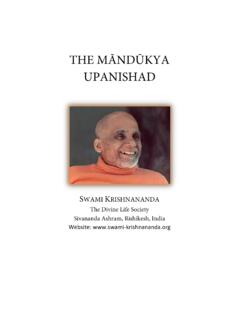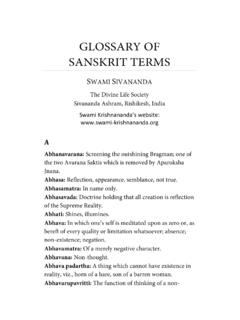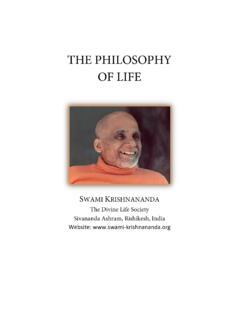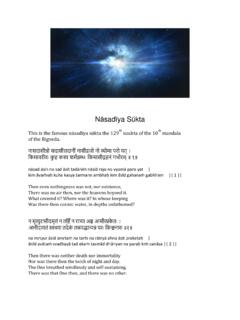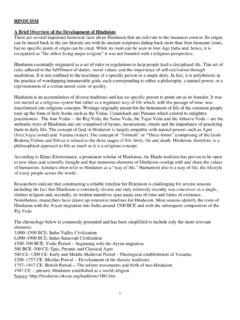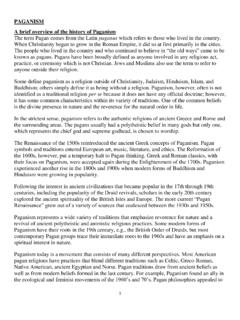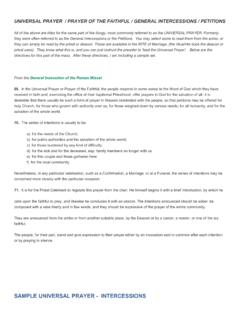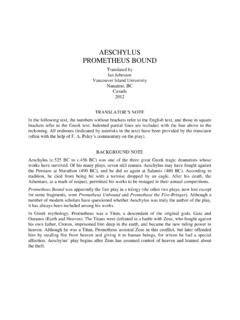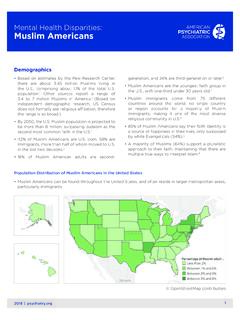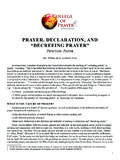Transcription of The Chhandogya Upanishad - Swami Krishnananda
1 THE Chhandogya Upanishad Swami Krishnananda The Divine Life Society Sivananda Ashram, Rishikesh, India Website: ABOUT THIS EDITION Though this eBook edition is designed primarily for digital readers and computers, it works well for print too. Page size dimensions are " x ", or half a regular size sheet, and can be printed for personal, non-commercial use: two pages to one side of a sheet by adjusting your printer settings. 2 CONTENTS Publishers Preface .. 6 Chapter I: Vaishvanara-Vidya .. 9 The Panchagni-Vidya .. 9 The Course of the Soul After Death .. 11 Vaishvanara, The Universal Self .. 58 Heaven as the Head of the Universal Self .. 65 The Sun as the Eye of the Universal Self .. 67 Air as the Breath of the Universal Self.
2 68 Space as the Body of the Universal Self .. 69 Water as the Lower Belly of the Universal Self .. 70 The Earth as the Feet of the Universal Self .. 70 The Self as the Universal Whole .. 71 The Five Pranas .. 78 The Need for Knowledge is Stressed .. 82 Conclusion .. 86 Chapter II: .. 91 Section 1: Preliminary .. 91 Section 2: The Primacy of Being .. 99 Section 3: Threefold Development .. 109 Section 4: Threefold Development (Contd.) .. 113 Section 5: Illustrations of the Threefold Nature .. 120 Section 6: Further Illustrations .. 123 Section 7: Importance of Physical Needs .. 124 Section 8: Concerning Sleep, Hunger, Thirst and Dying .. 128 Section 9: The Indwelling Spirit .. 139 Section 10: The Indwelling Spirit (Contd.) .. 143 Section 11: The Indwelling Spirit (Contd.)
3 146 Section 12: The Indwelling Spirit (Contd.) .. 149 3 Section 13: The Indwelling Spirit (Contd.) .. 152 Section 14: The Indwelling Spirit (Contd.) .. 155 Section 15: The Indwelling Spirit (Contd.) .. 162 Section 16: The Indwelling Spirit (Contd.) .. 167 Chapter III: Sanatkumara s Instructions on Bhuma-Vidya .. 173 Section 1: Name .. 175 Section 2: Speech .. 185 Section 3: Mind .. 188 Section 4: Will .. 192 Section 5: Memory .. 196 Section 6: Contemplation .. 199 Section 7: Understanding .. 201 Section 8: Strength .. 204 Section 9: 207 Section 10: Water .. 211 Section 11: Heat .. 212 Section 12: Ether .. 214 Section 13: Memory .. 217 Section 14: Hope .. 220 Section 15: Life .. 223 Section 16: Truth .. 229 Section 17: Truth and Understanding.
4 230 Section 18: Thought and Understanding .. 232 Section 19: Faith .. 233 Section 20: Steadfastness .. 234 Section 21: Activity .. 235 Section 22: Happiness .. 236 Section 23: The Infinite .. 241 Section 24: The Infinite and the Finite .. 244 Section 25: The Ego and the Self .. 247 4 Section 26: The Primacy of Self .. 251 Chapter VI: An Analysis of the Nature of the Self .. 257 Section 1: The Universal Self Within the Heart and in the World .. 257 Section 2: Different Higher Worlds .. 272 Section 3: The Space Within the Heart .. 274 Section 4: Life Beyond .. 283 Section 5: Importance of Brahmacharya .. 286 Section 6: Course After Death .. 291 Section 7: Prajapati s Instruction to Indra Concerning the Real Self .. 299 Section 8: The Bodily Self.
5 304 Section 9: Indra Feels the Inadequacy of the Physical Theory .. 308 Section 10: The Dream Self .. 311 Section 11: The Self in Deep Sleep .. 314 Section 12: The Self as Spirit .. 316 Section 13: Exclamation of the Perfected Soul .. 341 Section 14: The Prayer of a Seeker for Eternal Life .. 343 Section 15: Parting Advice to the Pupil .. 345 Appendix I: Sandilya-Vidya .. 353 Appendix II: Samvarga-Vidya .. 366 5 PUBLISHERS PREFACE The Chhandogya Upanishad is one of the most prominent among the major group of philosophical and mystical texts constituting one of the threefold foundation of India s spiritual lore, the tripod of Indian Culture, being constituted of the Upanishads, the Brahmasutras and the Bhagavadgita.
6 While the Veda Samhitas are the recognised primary source of divine inspiration, their hidden intention, purported message, is supposed to be prominently revealed in the Upanishads. The Vedas are said to be capable of a variety of interpretation, a knowledge of the adhidaiva or the transcendent divinity, adhibhuta or the created universe, adhyatma or the deepest subjective consciousness, adhiyajna or the field of action and sacrifice, and adhidharma or the function of law and order. Though, in a restricted sense, the adhyatma, in this mentioned classification, may appear as an insight into the perceiving and knowing subject as distinguished from its involvements in the objective universe and the transcendent divinity, thus categorising the Upanishads as records of inward revelations of the ancient sages, yet, the Upanishads constitute Adhyatma-Vidya or knowledge of the pure self in a wider sense, inasmuch as the self can be envisaged in the different degrees of its connotation and the many levels of its expression.
7 God above, the universe outside, the society of persons and things in the midst of whom one s own individuality may be included, are all, in the final analysis, comprehended within the status of the Absolute Self, so that, in its broad outlook the Upanishads 6 may be considered as a groundwork in whose light may be studied every branch of knowledge and learning. Among the ten major Upanishads, the Chhandogya and the Brihadaranyaka stand above others in their grand stature and majesty, these two texts being viewed by scholars as representing the cosmic and the acosmic aspect of Reality. In the Brihadaranyaka there is a preponderating emphasis on the ultra-spiritual nature of every plane of existence and stage of evolution, a rather super-idealistic sweep of all the phenomena of experience.
8 The Chhandogya , however, tries to be more realistic in its rather matter-of-fact consideration of the issues of life. This is the reason why, evidently, there is a prevalent feeling that the Chhandogya is saprapancha (considerate as to the visible forms of experience), while the Brihadaranyaka is nishprapancha (transcendent to all available experience). This exposition of the Chhandogya Upanishad is, perhaps, the most in-depth study ever made of its philosophical and spiritual message, and goes certainly as a companion to the author s interpretative exposition of the Brihadaranyaka Upanishad in a separate volume. Herein, the first chapter constitutes a brilliant study of the Panchagni-Vidya and the Vaishvanara-Vidya sections occurring in the fifth chapter of the original text.
9 This single chapter of the book may well form a classical presentation of a grand theme for the cosmical meditations characteristic of the Upanishads in general. The second chapter expounds the great content of sixth chapter of the original, constituting the instruction of Sage Uddalaka to his son Svetaketu. The third chapter is a study of the 7 seventh section of the original, dealing with the majestic Bhuma-Vidya, being the teaching of Sage Sanatkumara to Narada. The fourth chapter studies the eighth section of the original, which actually concludes the Upanishad . The Samvarga-Vidya and the Sandilya-Vidya occurring at other places in the Upanishad are also included in the end as pieces of stimulating meditation of absorbing interest.
10 The internal details of this vast study of the Upanishad can be gathered from the list of contents appended herein. May this valuable production come as a solacing blessing to seekers of Truth the world over. THE DIVINE LIFE SOCIETY Shivanandanagar, 23rd January, 1984. 8 Chapter One VAISHVANARA-VIDYA THE PANCHAGNI-VIDYA The Upanishads are mainly meditations intended to act as correctives to the binding effects that are produced by the phenomena of natural processes. While what we call a natural process subjects us to its own laws, these laws can be overcome and their imposition upon the individual can be counteracted by techniques of meditation. The philosophy of the Upanishads is that it is an ignorance of the way in which the Universe works that binds the individual to samsara, the series of births and deaths.
